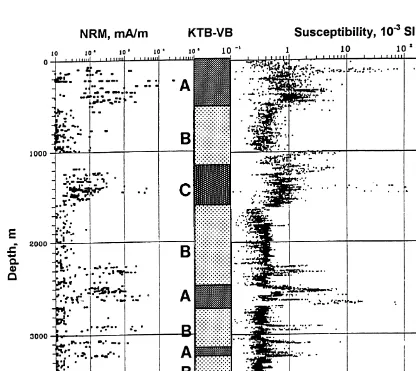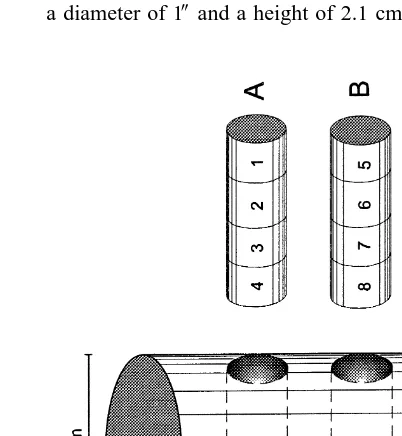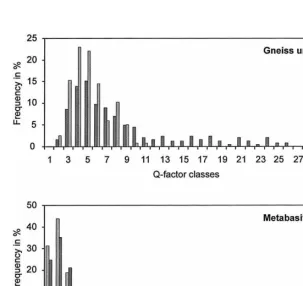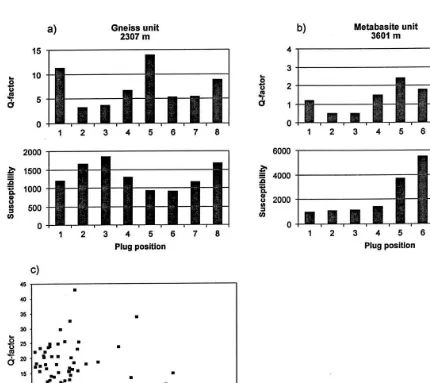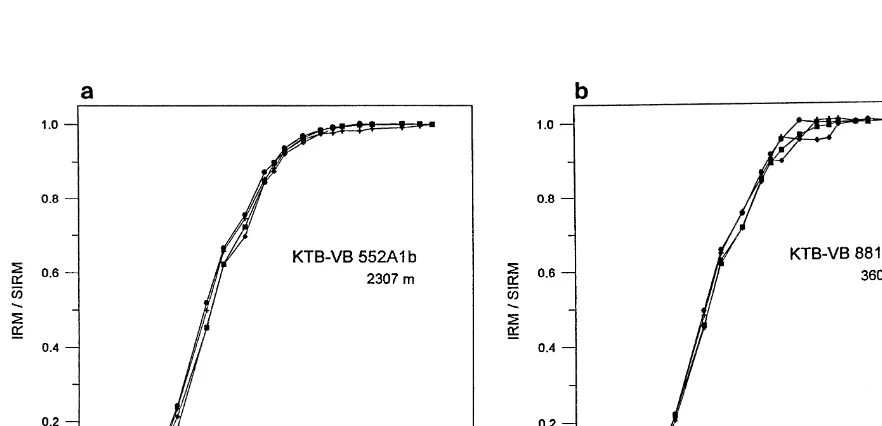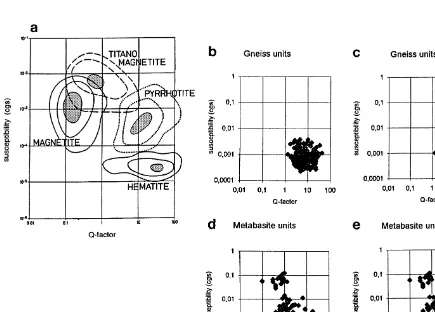www.elsevier.nlrlocaterjappgeo
Recognition of drilling-induced remanent magnetization by
Q-factor analysis: a case study from the KTB-drillholes
Helga de Wall
a,), Horst-Ulrich Worm
ba
Geologisch-Palaontologisches Institut, Ruprecht-Karls-Uni¨ Õersitat, Im Neuenheimer Feld 234, D-69120 Heidelberg, Germany¨
b
Bundesanstalt fur Geowissenschaften and Rohstoffe, Aussenstelle Grubenhagen, D-37574 Einbeck-Rotenkirchen, Germany¨ Received 30 September 1999; accepted 20 October 2000
Abstract
Ž . Ž
Drilling-induced magnetizations DIRM have been detected in the rocks of the KTB German Continental Deep Drilling
. Ž .
Program by determining the Konigsberger factor Q-factor , the ratio of remanent to induced magnetization. Specimens¨
Ž .
from the outer part of the drillcores show significantly enhanced Q-factors up to 10 times compared to those from the internal part. Contamination by coating with abrasive material, for example from the drill bit, and grain size variations due to cutting action of the diamond coring system, can be excluded. The DIRM is interpreted to be caused by the magnetization of the core barrel and drill string, which produce higher fields close to rim than in the interior of the drill core. After removing the DIRM contaminated samples from the database, the Q-factors for the main KTB rock units have mean values of 4.8 for the gneiss units and 1.6 for the metabasite units. The uncontaminated data set fits in the appropriated field of the
w Ž . x
susceptibility—Q plot of Henkel J. Appl. Geophys. 32 1994 43–53 for metamorphic continental rocks.q2001 Elsevier
Science B.V. All rights reserved.
Keywords: Drill cores; Secondary magnetization; Koenigsberger ratio; German Continental Deep Drilling Program
1. Introduction
Measurements of remanent magnetization on cores from drillholes often reveal a secondary component of magnetization, which is acquired during the drilling process and referred to as the
drilling-in-Ž .
duced remanent magnetization DIRM . A large
number of studies have been undertaken in order to obtain information about the origin of such DIRM effects. Possible sources that have been discussed are
)Corresponding author. Fax:q49-6221-545503.
Ž .
E-mail address: [email protected] H. de Wall .
Ž
the effects of stress due to cutting Burmester, 1977; .
Jackson and Van der Voo, 1985 or of shock
associ-Ž .
ated with the drilling process Lauer, 1978 . In a
Ž .
detailed study by Audunsson and Levi 1989 on titanomagnetite-bearing drill cores from the Columbia River Basalt, DIRM was identified and attributed to a magnetic field induced by the core barrel. These effects were found to be highest at the core rim and decreased toward the internal part of the core. These authors excluded contamination of the drill core on its surface caused by metal abrasion of the drilling equipment as a secondary source of magnetization. The magnetic field acting at the tip of the core barrel during drilling have been modelled by Pinto and
0926-9851r01r$ - see front matterq2001 Elsevier Science B.V. All rights reserved.
Ž .
Ž .
McWilliams 1990 and they found good agreement between the modelled field and the measured field of the drilling equipment. The strongest magnetic field is always measured at the tip of the core barrel and it decreases towards the center of the aperture. Signifi-cant variations in the magnetic field strength pro-duced by the core barrel have been recorded from different drilling projects. For example, fields were only 0.15 mT on the core barrel used for the pilot
Ž .
hole of the Continental Deep Drilling Program KTB
Ž .
of Germany Pohl et al., 1991 , but up to 5 mT near Ž
the joints of the drill string Worm, unpublished
. Ž
results , 2.5 mT for the Cajon Pass drilling Pinto .
and McWilliams, 1990 , 1 to )10 mT for the
Ž .
Ocean Drilling Program Fuller and Hasted, 1997 , and up to 20 mT for the Columbia River Basalt
Ž .
drilling Audunsson and Levi, 1989 . Such variations are likely to depend on the material properties of the
Ž .
core barrel itself. In addition, Pohl et al. 1991
considered the effect of the drilling rig, after core recovery, where fields on the order of 1 mT were measured for the KTB.
Characterization and quantification of DIRM components is of importance in the earth sciences, if the remanent magnetization of drill cores is to be used for paleomagnetic and magnetostratigraphic analyses or the modelling of source layers of mag-netic field anomalies. Recognition of these secondary effects is also critical in drilling projects where the direction of the viscous remanent magnetization is used for the reorientation of drill cores. Separation of the secondary DIRM component from the primary
Ž .
natural remanent magnetization NRM can be
achieved, for example, by stepwise demagnetization with an alternating field or by a thermal demagneti-zation routine. However, this procedure is generally time-consuming and requires special analytical facili-ties. For the interpretation of data from drillholes where dense sampling is applied, a quick and routine procedure for recognizing DIRM components is de-sired.
In this paper, results are presented from investiga-tions of the remanent magnetization in the
Continen-Ž .
tal Deep Drilling Program of Germany KTB . Al-though former studies considered DIRM effects in
Ž .
the KTB Pohl et al., 1991; Worm and Rolf, 1994 , no systematic characterization of these secondary influences were made. This study attempts to
recog-nize and characterize DIRM by determining the
Ž .
Konigsberger-ratio Q-factor of magnetization. The
¨
Q-factor is defined as the ratio between remanent
magnetization and the magnetization induced in the
geomagnetic field, QsNRMrk=H, where k is the
magnetic susceptibility. Technical magnetic fields that induce a DIRM can reach magnitudes several times that of the geomagnetic field and therefore, if a significant DIRM is acquired, the measured rema-nent magnetization can be considerably higher than the undisturbed NRM, thus resulting in elevated
Q-factors. It will be demonstrated that the Q-factor
can provide quick information concerning the en-hanced magnetic field acting during the acquisition of remanence and therefore can be used to detect drilling-induced magnetization in core material.
1.1. Drillingrcoring equipment
Two deep boreholes were drilled during the KTB
Ž .
research program 1987–1994 . A pilot hole reached a depth of 4000 m, with in situ temperatures of up to
Ž .
1808C KTB-Vorbohrung, KTB-VB , and the
ultra-deep main hole was drilled down to 9100 m, with Ž
temperatures of 2608C reached at the base
KTB-.
Hauptbohrung, KTB-HB . This study is focussed on samples from the KTB-VB from which a nearly
Ž .
complete core diameter of 94 mm is available,
extracted by wireline recovery technique with dia-mond coring systems. A spin of 250–350 Urmin
Ž .
was used for cutting the cores Engeser, 1995 .
1.2. Magneto-minerology of the KTB rocks
The KTB drill holes passed through a sequence of metamorphic rocks constituting the Variscan base-ment of the Bohemian Massif in East Bavaria,
Ger-Ž .
many Hirschmann et al., 1997 . Three main types of rock units have been defined: gneiss units that mainly consist of paragneisses and minor intercalations of amphibolites; metabasite units that are composed of amphibolites, metagabbros and metaultramafic rocks; and a subordinate varied unit of alternating
metavol-Ž
canics, paragneisses and amphibolites Harms et al., .
Ž .
profile Duyster et al., 1995 . In this study, we
investigate samples from the gneiss and metabasite units, which cover the major part of the drilled
Ž .
profile in the KTB-VB Fig. 1 . The average
suscep-y6 Ž .
tibilities are around 400=10 SI-Units in the
gneiss units and 1000=10y6 in the metabasite units
ŽBerckhemer et al., 1997 which are mainly due to.
paramagnetic minerals such as biotite in the gneisses and hornblende in the metabasite lithologies. How-ever, locally the susceptibilities are increased up to )10y2, due to ferrimagnetic minerals.
Pyrrhotite was found to be the main carrier of remanence in both the gneiss and metabasite units of the KTB-VB and KTB-HB. But whereas pyrrhotite is the only ferrimagnetic mineral present in the gneiss units, the rocks of the metabasite units may locally
Ž
also contain some magnetite Berckhemer et al.,
.
1997; Kontny et al., 1997 . Especially in ultramafic intercalations high magnetic susceptibilites up to 0.15 ŽSI-units are related to the presence of magnetite. In. the gneiss units of the KTB-VB ferrimagnetic and antiferromagnetic pyrrhotites are intergrown while in
Ž .
Fig. 1. Schematic profile of the KTB-VB and susceptibility and remanence log whole core measurements from quasi-continuous
Ž . Ž . Ž . Ž .
Ž
Fig. 2. Typical thermomagnetic curves low field susceptibility
.
measured in SI units for the KTB rock units. The susceptibility is
Ž .
given in arbitrary units. a Example from the paragneiss units, showing two pyrrhotite phases: antiferromagnetic pyrrhotite which
Ž .
is indicated by al-transition at 2208C and Curie temperature Tc
at 2658and ferrimagnetic pyrrhotite with distinct Hopkinson Peak and T of 320c 8C. Measurements are undertaken in air, therefore an oxidation under formation of magnetite occurs at elevated
temper-Ž .
atures. b Metabasite units with mainly ferrimagnetic pyrrhotite
ŽTc 3208C and a very low magnetite component T. Ž c 5908C ..
Measurements are performed in argon atmosphere.
the metabasites the ferrimagnetic type predominates ŽKontny et al., 2000 . The grain size for the ferri-. magnetic pyrrhotite ranges mainly from 10 to 100
mm in both rock units and the grains show
multido-Ž .
main characteristics Kontny et al., 1997 . In Fig. 2, thermomagnetic curves are presented that reflect the typical magneto-minerology of the investigated rock
Ž
units with two-phase pyrrhotite ferrimagneticq
.
antiferromagnetic predominating in the gneisses and
Ž .
a single pyrrhotite phase ferrimagnetic in the
metabasites.
1.3. Sampling routine
This study uses the database that has been ob-tained during routine magnetic measurements on the KTB drill cores in the magnetic laboratory of
Ž .
Grubenhagen Geol. Survey of Lower Saxony . Re-sults presenting these measurements were previously
Ž .
published by Worm and Rolf 1994 . The sample sites for this database have been selected on the basis of the continuously measured susceptibility on the drill cores, performed at the KTB field laboratory ŽBucker et al., 1990 . Samples are taken from sec-
¨
. tions with high susceptibilities and remanence val-ues, which reflected the occurence of ferrimagnetic minerals within the paragneiss and metabasite units ŽFig. 1 . These sections are of interest because they. contribute to the magnetic anomaly found in the areaŽ .
of the KTB location Pucher, 1986, 1994 .
At each sampling site, two plugs were drilled, in order to obtain a total of eight specimens, each with
Y
Ž .
a diameter of 1 and a height of 2.1 cm Fig. 3 . For
each specimen, the susceptibility and the remanent magnetization were measured and the Q-factor has been calculated. The database contains measure-ments on 523 gneiss and 636 metabasite specimens, however, for this study we considered only those specimens with remanence values higher than 50
Ž .
mArm 245 gneisses, 198 metabasites as the NRM measurements were performed with a relatively low-resolution spinnermagnetometer.
2. Results
In general, specimens from the gneiss and metab-asite units show strong variations in Q-values with a wide range of scattering between 1.3–45.4 and 0.1–
Ž .
18.6, respectively Fig. 4 . The mean value for the gneiss units is 8.6"6.7, which is significantly higher
Ž .
Fig. 5. Q-factors in relation to the plug position see Fig. 3 shown for 12 samples from a gneiss section. The Q-factors are signifi-cantly enhanced in the outermost specimens of the two plugs
Žpositions 1, 4 and 5, 8, respectively ..
than the mean Q-factor for the metabasites at 2.2" 2.0. This difference in the mean values of the Q-fac-tor may reflect the differences in the magne-tominerology between the rock types.
Ž . Ž . Ž .
One reason for the scatter of Q-factors becomes obvious when the data are compared with the posi-tion of the measured specimen within the drilled plugs. Specimen nos. 1 and 4, as well as nos. 5 and 8, from the outermost parts of the drill core, reveal significantly higher Q-factors than specimen nos. 2, 3, 6, and 7, which are located around the center of the drill core. For example, this pattern is evident in the presentation of Q-factors for 12
sam-ples from a paragneiss section taken from the inter-val 2250–2350 m, where the Q-inter-values are shown in
Ž .
relation to their position in the drilled plugs Fig. 5 . In the outer parts, the Q-factors are significantly enhanced and reach maximum values of up to 42.8, while in the internal parts, values do not exceed a
Q-factor of 10. The highest value for the Q-factor
measured in the whole KTB-VB profile reached 45.4 in hornblende-bearing gneisses at 2574.33 m.
Ž . Ž .
Fig. 6. The diagrams a to c give evidence that there is no correlation between the magnitude of susceptibility and the Q-factor. Examples
Ž . Ž . Ž
are given from the gneiss a and metabasite b units that show the Q-factor and susceptibility for different plug positions susceptibility
y6 . Ž . Ž .
given in 10 SI units . In c , the Q-factor is plotted vs. the susceptibility for samples from the gneiss sections a total of 210 specimens .
Ž . Ž
Specimens from the outermost positions 1, 4 and 5, 8 presented in filled squares as well as the specimens from the inner positions 2, 3
.
In order to exclude that this distribution is related to the magnitude of susceptibility that might be enhanced in the outer samples by coating of metal abrasive materials from the core barrel, we compared the Q-factors with the susceptibility values. In Fig. 6a, the Q-factor is plotted against the magnitude of susceptibility for paragneisses with a significant
fer-Ž y6.
rimagnetic contribution k)500=10 .
Evi-dently, there is no correlation between these two magnetic parameters. This holds for the samples from the internal as well as from the outer part of the drill cores. That susceptibility and Q-factors are not related is also documented in Fig. 6b,c. Here, exam-ples are shown from both gneiss and metabasite units, where the susceptibility values and Q-factors are compared for eight specimens from different
Ž
plug positions of a sampling site as shown in Fig. .
3 . From these results, a contamination of the drill core by drilling artifacts can be excluded.
Furthermore, we performed acquisition curves for
Ž .
the isothermal remanent magnetization IRM which provides information concerning the differences in grain sizes and domain structure. In Fig. 7, the IRM
curves for specimens from the different plug posi-tions are compared for both gneiss and metabasite lithologies. There is no variation observed between the specimens with relatively high Q-factors from the outermost parts of the core and those with lower Q-factors, from the internal parts of the core. Samples from the gneiss and metabasite units show an identical course of IRM-acquisition curves, with weak magnetic behavior where more than 90% of magnetization is acquired in a magnetic field
-100 mT. This is consistent with a multidomain
state of the pyrrhotite that has also been observed in
Ž .
reflected light microscopy Kontny et al., 2000 . These investigations show clear evidence for the enhancement of the Q-values in samples from the outermost parts of the drillcore. After eliminating these specimens from the bulk of the measured samples, a mean Q-value of 4.8"1.9 is calculated
Ž
for the gneiss units considering only specimens
.
from position nos. 2, 3, 6, and 7 . For the metabasite units, the mean value is significantly lower with 1.57"1.04 as measured from the internally posi-tioned specimens.
Ž . Ž .
Fig. 7. IRM-acquisition curves for examples from the gneiss a and metabasite b units. Each diagram comprises data of four specimens
Ž . Ž .
from a drilled plug positions 1 to 4, see Fig. 3 . For a , the Q-factors are 14 and 9 for the outer specimens and 5 for both inner specimens,
Ž .
3. Discussion
Based on the analyses of the Q-factors of magne-tization, the influence of DIRM on the remanent magnetization is recognized for the rocks of the KTB. Contamination of the drill core that may en-hance the susceptibility, such as that arising from coatings of abrasive material from the drill bit, can be excluded. Grain size variations due to the cutting action of the diamond coring system that could influence the grain size distribution can also be neglected. Having excluded these possible contribu-tions, we consider that the magnetic field of the core barrel is the principle source for the DIRM.
There are differences in the magnitude of DIRM for the two main rock types recovered from the KTB
drillholes. A strong influence of DIRM is found in paragneisses. A mean value for the Q-factor of 8.6 was reduced to 4.8 after removing specimens from the outer parts of the drill core, which presents a reduction of 44%. In metabasites, the influence of DIRM is weaker. The mean Q-factor decreased from
Ž .
2.2 to 1.6 27% after correction of the data. These
Q-factors from the inner core area are considered to
represent more reliable values for the calculation of magnetization for these KTB rocks. This might have an influence on the modeling of magnetic anomalies
Ž .
in the KTB-area Bosum et al., 1997 .
As the drill site is situated in a crystalline base-ment complex, we compared the obtained Q-factors for the gneisses and metabasites with other magnetic
Ž .
data for basement rocks published by Henkel 1994 .
Ž . Ž .
Fig. 8. Combined susceptibility-Q-value diagrams susceptibility in cgs units . a Standard-diagram based on data from the
Nordkalott-pro-Ž . Ž . Ž . Ž .
ject Henkel, 1994 . b Paragneiss units, all specimens; c paragneiss units, specimens from the internal part of the core only; d
Ž .
He presented a statistical analysis of 31,183 samples Ž
from metamorphic rocks of Scandinavia Nordkalott .
project and introduced a combined
susceptibility-Q-value plot where fields for different
magne-tominerologies were discriminated. Overall, the KTB data matches well with this discrimination diagram
Ž for the magnetic parameters of basement rocks Fig.
.
8 . The data from the gneiss units plot in the field for pyrrhotite-bearing rocks, which are characterized by
Q-factors of around 10. However, the data for the
metabasite units plot between the fields for pyrrhotite and magnetite and show an increase in susceptibility which corresponds to the decrease in Q-values. This increase in susceptibility is related to an increasing magnetite content at the expense of pyrrhotite which
Ž
leds to correspondingly lower Q-factors see Fig.
. Ž .
8a . The lowest Q-values 0.1–1 are related to
ultramafic rocks that bear magnetite and show the highest susceptibilities.
We have shown in this study that the remanent magnetization may be significantly enhanced by sec-ondary effects induced during the drilling process. Such factors can cause an increase in the Q-values up to 10-fold in magnitude. It is therefore critical that these secondary effects are considered before using NRM intensity data for geophysical modelling. The magnetic field of the core barrel and the drill string may also induce a secondary magnetization in the borehole-wall which affect borehole anomalies measured with a downhole magnetometer. The statis-tical analysis of Q-factors obtained from sections perpendicular to the core axis therefore presents a quick and useful method for the recognition of DIRM in magnetic databases of drilling projects, where large quantities of data can easily be checked for this secondary overprint.
Acknowledgements
We thank Dr. C. Rolf for providing the data from the KTB measurements in Grubenhagen and L. Nano for his help in preparing the diagrams. H.C. Soffel and an anonymous reviewer provided helpful com-ments for the improvement of the final manuscript. The KTB research work was supported by the
Ger-Ž .
man National Foundation DFG . We are grateful for financial support by the grants Wa1010r1 and Bo 822r4.
References
Audunsson, H., Levi, S., 1989. Drilling-induced remanent magne-tization in basalt drill cores. Geophys. J. 98, 613–622. Berckhemer, H., Rauen, A., Winter, H., Kern, H., Kontny, A.,
Lienert, M., Nover, G., Pohl, J., Popp, T., Schult, A., Zinke, J., Soffel, H.C., 1997. Petrophysical properties of the
9-km-Ž .
deep crustal section at KTB. J. Geophys. Res. 102 B8 , 18.337–18.361.
Bosum, W., Casten, U., Fieberg, F.C., Heyde, I., Soffel, H.C., 1997. Three-dimensional interpretation of the KTB gravity and
Ž .
magnetic anomalies. J. Geophys. Res. 102 B8 , 18.307– 18.321.
Bucker, C., Huenges, E., Lippmann, E., Rauen, A., Streit, K.M.,¨ Wienand, J., Soffel, H.C., 1990. KTB pilot hole. Results obtained in the KTB Field-Laboratory. KTB Report 90-8: D1–D29, Hannover.
Burmester, R.F., 1977. Origin and stability of drilling induced remanence. Geophys. J. R. Astron. Soc. 48, 1–14.
Duyster, J., Kontny, A., de Wall, H., Zulauf, G., 1995. Post-variszische Krustenstapelung am Westrand der Bohminschen¨
Ž .
Masse. Geowissenschaften 13 4 , 135–141.
Engeser, B., 1995. Das Kontinentale Tiefbohrprogramm der Bun-desrepublik Deutschland, KTB, Bohrtechnische Dokumenta-tion. KTB Report 95-3, 799 S., Hannover, ISSN 0939-8732.
Ž .
Fuller, M., Hasted, M., 1997. Magnetic fields of 1 bottom hole
Ž . Ž .
assemblies, 2 advanced piston core inner barrels and 3 inner shoes. Ocean Drilling Program, Initial Res. Leg. 166. Harms, U., Hirschmann, G., Lich, S., Pechnig, R., de Wall, H.,
1993. Gneisses of the KTB Vorbohrung and Hauptbohrung: I. Lithological units, Subdivision and Correlation. In: Emmer-mann et al., Contribution to the 6th Annual KTB-Colloquium-Geoscientific Results, KTB Report 93-2, 67–74. Henkel, H., 1994. Standard diagrams of magnetic properties and
density—a tool for understanding magnetic properties. J. Appl. Geophys. 32, 43–53.
Hirschmann, G., Duyster, J., Harms, U., Kontny, A., Lapp, M., de Wall, H., Zulauf, G., 1997. The KTB superdeep borehole: petrography and structure of a 9-km-deep crustal section. Geol. Rundsch. 86, 3–15.
Jackson, M., Van der Voo, R., 1985. Drilling-induced remanence in carbonate rocks: occurrence, stability and grain-size depen-dence. Geophys. J. R. Astron. Soc. 81, 75–87.
Kontny, A., Friedrich, G., Behr, H.J., de Wall, H., Horn, E.E., Moller, P., Zulauf, G., 1997. Formation of ore minerals in¨ metamorphic rocks of the German Continental Deep Drilling
Ž . Ž .
Site KTB . J. Geophys. Res. 102 B8 , 18.323–18.336. Kontny, A., de Wall, H., Sharp, T., Posfai, M., 2000. Mineralogy
Lauer, J.-P., 1978. Creation d‘aimantations remanentes de sciage´ et de forage au cours de la preparation d‘echantillons de´ ´ roches destines a une etude paleomagnetique. C. R. Acad. Sci.´ ` ´ ´ ´ Paris, Ser. D 287, 1–4.
Pinto, M.J., McWilliams, M., 1990. Drilling-induced isothermal remanent magnetization. Geophysics 55, 111–115.
Pohl, J., Patzold, T., Rolf, C., Soffel, H.C., Worm, H.-U., 1991. A¨ rock magnetic log of the KTB pilot borehole. Sci. Drill. 2, 120–129.
Pucher, R., 1986. Interpretation der magnetischen Anomalie von
Ž .
Erbendorf Oberpfalz und dazugehorige gesteinsmagnetische¨ Untersuchungen. Geol. Jahrb., E 33, 31–52.
Pucher, R., 1994. Pyrrhotite-induced aeromagnetic anomalies in western Germany. J. Appl. Geophys. 32, 33–42.
